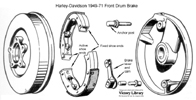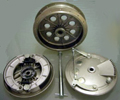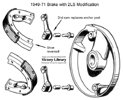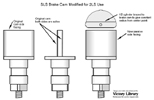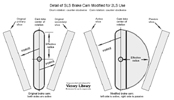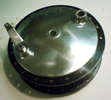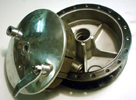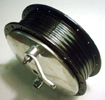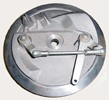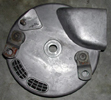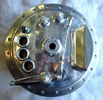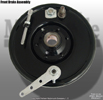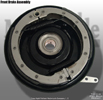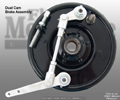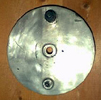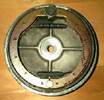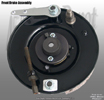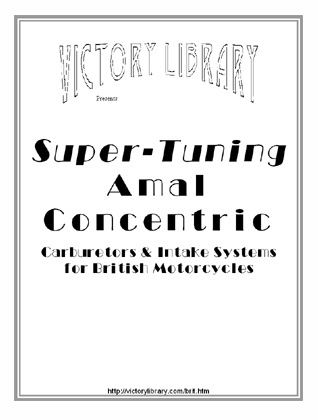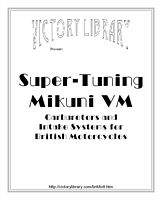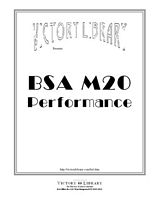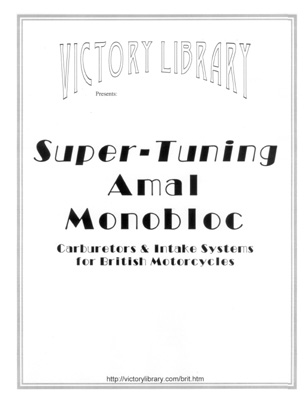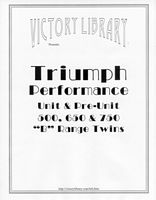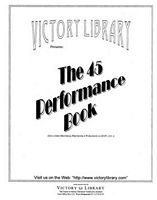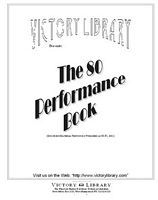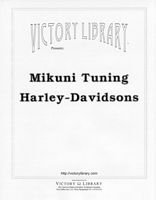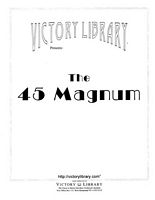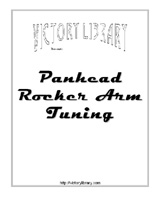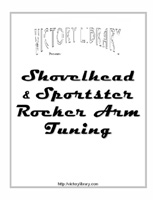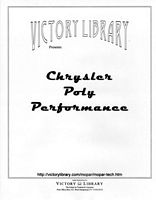|
|
 |
Converting H-D Drum Brakes to Dual Leading Shoe
|
Original equipment brakes
Harley-Davidson motorcycles equipped with front brakes used only drum brakes until 1972. The type used was “single leading shoe”, where each drum carries two lined brake shoes which are moved in opposite directions by a single eccentric cam (as shown here), which is rotated by a lever on the brake backing plate. This lever is controlled by a cable (front brake) |
 |
|  | |
or rod (rear brake). |
If the cam rotates clock-wise, the upper half pivots to the right and contacts the right shoe, the lower half pivots left and contacts the left shoe. As shown in the diagram, the movement and mechanical advantage is not exactly equal between the two shoes, since the top of the cam moves farther for the same number of degrees of rotation, |
 | |
contacting the right shoe at the top with more leverage. The bottom of the cam moves less for the same number of degrees of rotation and contacts the left shoe at the top with less leverage. However, the result is harmless.
The “dead” (fixed and passive) end of both shoes are concave to accept a cylindrical anchor post which is bolted through the backing plate opposite the cam. Frequently the post shaft and cam shaft are the same diameter and exactly 180° apart. Various models were used in different diameters and shoe widths, but even the last and best, the 1964-72 Sportster 8” full-width drum, is not sufficient for performance use. |
Single leading shoe components |
The “secondary” or “trailing” shoe (only present in single leading shoe systems, also called “1LS” or “SLS”) is applied against the direction of drum rotation by the rotation of the brake cam, which forces it away from the drum surface. The friction (and heat transfer, and effectiveness) is limited to the leverage and pressure of the cam. This system works equally well in either direction, and therefore prevents “roll-back”. |
The “primary” or “leading” shoe (always present) is applied in the direction of drum rotation by the rotation of the brake cam, which “wedges” the leading edge of the shoe against the drum surface. The friction is the total of the wedging action, plus the leverage and pressure of the cam. In addition to increased pressure, this is also has a self-energizing “servo” effect in that the primary shoe is more tightly wedged in place by drum rotation without additional cam movement, so its effect increases automatically without any cam or hand-lever motion. The amount of torque contributed by a leading shoe is 27.9% higher than that of a trailing shoe, the proportionate effect of the primary vs. secondary shoe is roughly 56% vs. 44%. |
A dual leading shoe system (also called “2LS” or “DLS”) substitutes another primary shoe and its cam &c. for the existing secondary shoe. This increases the braking force by about 14% (½ of the 27.9% higher effectiveness of the extra primary shoe since only one shoe is being changed). This makes for a lighter but more delicate control. A dual leading shoe system only works in the designed |  |
|
direction, and is almost useless when reversed. Grimeca 230mm 4LS components are shown here, right. Notice the two cam levers, with connecting linkage. The 2nd backing plate is not shown, but would be a mirror image of the one in the right foreground, and visible through the drum holes. Click the picture for a larger view. Harley-Davidson never used this type in any production motorcycle, although they recognized its value when they needed a better front brake for the KR and out-sourced to Fontana for a four leading shoe drum. |
Conversion to dual leading shoe |
Some original Harley-Davidson backing plates can be
converted to 2LS for a dramatic improvement in braking power with some minor machine work. If the plate has a removable post to retain the “dead” (fixed) end of the shoes, this can frequently be replaced with a new cam (inside the backing plate) and lever (outside the plate). The existing secondary shoe is either replaced by another |
 |
|
primary shoe reversed (preferred, the material and thickness may be different), or simply reversed,and external linkage added. This has been done successfully by the Triumph & BSA factories to the 1967 SLS drums, by aftermarket manufacturers to the Harley-Davidson 1936-57 spring fork drum, and by individual tuners to the 1964-72 Sportster full-width drum. |
Cam fabrication |
All of the Harley-Davidson cams I’ve seen are flat-sided rectangles (as shown above), which move the active ends of the primary and secondary shoe simultaneously. They will not work “as-is”, since both ends of both shoes would move. Both the original and new cams must be modified or fabricated to provide an eccentric motion on only one side to contact the active end of one |  |
|
shoe, and the other side rounded to rotate by the passive edge of the other shoe without imparting movement. |
A piece of thick-walled tubing (pipe, &c.) or bar stock with the diameter the same as the width of the cam and the same height can be cut in half length-wise, forming two half-cylinders. If tubing is used it should be capped at each end with a ½-circle of plate to prevent collapse. Now grind each cut surface down by ½ the thickness of the cam. When brazed or welded onto |  |
|
the cam surface this now forms a radius at a constant distance from the end of the passive shoe, and will rotate past rather than move the shoe. The pressure between the radius and the passive end is only the return spring tension, so wear will not be a problem with normal lubrication. The final shape is made geometrically accurate by turning the cam on a lathe to make the OD of the radius concentric with the cam shaft. This need not be perfect to within .001”; as long as any eccentric movement is less than the distance from the shoe to the drum in normal (spring-loaded) position it will work even if not perfect, but try to get it very close.
Before assembly, the old secondary shoe must be prepared to match the primary shoe. The leading edge of the lining at the active end must be chamfered to match the primary shoe to allow the ”wedging” action to take place without “grabbing”. If the brake grabs or chatters, removes slightly more material from the active shoe at an angle. Be careful not to thin the shoe too much, or the rivetted area will crack. The chamfer distance in the Harley-Davidson factory service manual is 5/8”, which is where I would start. Too much chamfer reduces the amount of lining in contact with the drum very slightly, but this is preferable to too little.
The only other alternative is adding an extra anchor post adjacent to each cam as was done with systems designed as 2LS originally. However, this requires a major re-design of all functions and dimensions. |
Linkage |
The cam levers on the exterior of the backing plate should be parallel when assembled. Rather than using two cables (possible but not practical), the preferred method is to make a link to connect the two levers and operate the original lever by a single cable. The mechanical advantage of the original lever will be preserved by using the original point of attachment of the cable. The connecting link should be in tension, attached to both levers slightly closer than the original cable, and must attach to both levers at exactly the same distance from the cam center, or the two cams will operate differently. In addition, try to arrange your link so that it does not interfere with a backing plate torque link, cable run, speedomater cable, &c. |
Here are some comments about specific Harley-Davidson drum brakes which may be of use, listed in descending order of size. I have not personally completed these modifications, but in my opinion they require only careful planning and execution.
|
1964-72 Sportster |
This is the largest and only full-width Harley-Davidson drum, also used on the 1971-72 Superglide. It would be barely adequate for a smaller and lighter motorcycle, but not for the Sportster. The existing backing plate has been successfully |
 |
|
converted as described above with another brake cam, etc. |
As an alternative, the 8” ID is common to the Triumph and BSA 1968-70 2LS (conventional full-width hub, left illustration) or 1971-72 2LS (conical hub, right illustration) brakes, and their backing plate assemblies complete with shoes and hardware may fit with some work. Click either picture for a larger image. The Triumph & BSA |  |
|
shoes are 1/8” wider than the Sportster (1-5/8” vs. 1-1/2”). The axle and spacer stack will require an adjustment to move the drum away by for clearance. Measure carefully, there may be problems I have not anticipated.
The Sportster shoes are too narrow to fit the BSA/Triumph backing plate without some work, including spacing the shoe away from the backing plate by about 1/16” to center it in the drum. The axle spacer, axle diameter &c. will all require some analysis and modification. |
Another possible alternative is the 8” Norton Atlas or Commando 2LS (conventional full-width hub) brake, shown here. Click the picture for a larger image. The Norton shoes are 1/4” narrow than the Sportster (1-1/4” vs. 1-1/2”). However, even with 2LS operation the 16.7% loss of lining area is substantial, and will reduce the value of the conversion; there may even be a net loss of braking effect. Using the |  |
|
Norton backing plate and shoes as an assembly will require an adjustment to the axle and spacer stack to position the drum properly. |
Using the Norton backing plate with the Sportster shoes will require require modification to the shoe ends and/or the brake cam to mount the shoes 1/8” higher for clearance to the backing plate, and an adjustment to the axle and spacer stack as well.
Measure carefully, there may be problems I have not anticipated. The lugs on the British backing plate that lock it to the British fork leg may interfere with your fork leg. Rather than remove the lugs, drill & tap the area for a stud and anchor a link back to the fork leg. |
There are some “metric” (European and Japanese) brakes that are close, but enlarging the drum’s ID to 210mm (8.268”) to accept the backing plate assembly from a 210mm brake is not possible. However, using a more common 200mm backing plate (7.874”) by adapting the Sportster shoes may work. The 200mm shoes would have to be lengthened at both ends or the anchor posts and cams modified, then the lining arc-ground to the larger radius, which will make them much thinner. |
Big twin Hydra-Glide |
This is the largest big twin drum, also used on the 1958-71 Servi-Car. It is completely inadequate for any performance use. The original backing plate (shown above) can be modified as described with a second cam in place of the anchor post, reverse and chamfer the trailing shoe, fabricate linkage etc.
Since the drum ID is also 8” (although the shoes are much narrower than the Sportster) the Norton 2LS brakes may prove useful here as well. The Norton shoes are 1/4” wider than the Hydra-Glide (1-1/4” vs. 1”). The axle and spacer stack will require an adjustment to move the drum away by for clearance.
The Harley-Davidson shoes are too narrow to fit the British backing plate without some work, including spacing the shoe away from the backing plate by about 1/8” to center it in the drum. The axle spacer, axle diameter &c. will all require some analysis and modification. |
An interesting, but more complex, conversion can be done using a drum on either side of the hub, either as dual SLS or converted to 2LS. My choice would be the 1967-72 Timken bearing “star” hub which also carries an extra bearing in the drum. The 1967-68 drum is positioned in traditional style on the left side of the motorcycle, but in 1969 H-D |
 |
|
began use of a mirror-image drum assembly on the right side of both the big twin and Servi-Car using the same drum, but with a different backing plate, cam, and lower legs. The early parts carry “-48” or “-67” numbers, the later parts carry “-69” numbers in the parts books.
With some machining to the hub and drums, two Timken drums can be installed using the older 1948 & 1967 parts on the left leg and the mirrored 1969 parts (backing plate and cam lever) on the 1969-71 right leg. Obviously, an axle etc. must be fabricated, the drums must be equally distant from the centerline, the cables joined or synchronized, etc. |
Big twin springer |
This brake was used 1936-48 on the big twins, and 1941-57 on the Servi-Car with spring forks. It is completely inadequate for any practical use. The drum ID is 7¼”, and is therefore in-between useful sizes of existing 2LS brakes. There is a 7” 2LS brake used on Triumph 500 etc. 1968-74, but the |
 |
|
same problems and requirements mentioned above apply. There are also many metric brakes in 180mm (7.087”), but these are both rather far away from the original size, and less likely to work without considerable modification. Another metric brake that looks useful is the rather obsolete 1968 Bridgestone 350 190mm (7.480”). |
The original backing plate (shown above, right) can be modified as described with a second cam in place of the anchor post, reverse and chamfer the trailing shoe, fabricate linkage etc. For those who wish to improve the braking with a purchase rather than a project, I suggest you explore the 45 Parts Depot brake (shown right), which is a |  |
|
brand-new (not rebuilt) product already re-designed with dual brake cams for improved stopping power. This is a direct bolt-on to your original or aftermarket “star” hub, and requires no assembly or extra parts, click here for more details:  . . |
K model and early Sportster |
This brake was used 1952-63 on the K, KH and 1957-63 Sportster. It is completely inadequate for any practical use. The drum ID is 7¼”, and is therefore, again, in-between useful sizes of existing 2LS brakes. The same problems and requirements mentioned above apply.
|
 |
|
The original backing plate (shown here) can be modified as described with a second cam in place of the anchor post, reverse and chamfer the trailing shoe, fabricate linkage etc. |
45 springer |
This brake was used 1930-52 on the 45 solo, and 1930-40 on the Servi-Car with spring forks. It is the smallest drum brake since 1930, and completely inadequate for any practical use. The drum ID is 6¾”, and is therefore, again, in-between useful sizes of existing 2LS brakes. The 7” Triumph 2LS brake is too large, 160mm (6.299”) metric brakes are too small. |
 |
|
The original backing plate (shown above) can be modified as described with a second cam in place of the anchor post, reverse and chamfer the trailing shoe, fabricate linkage etc.
Click here for a Table showing drum brakes grouped by drum ID, then sorted by index of efficiency with strongest first:  . .
|
|




